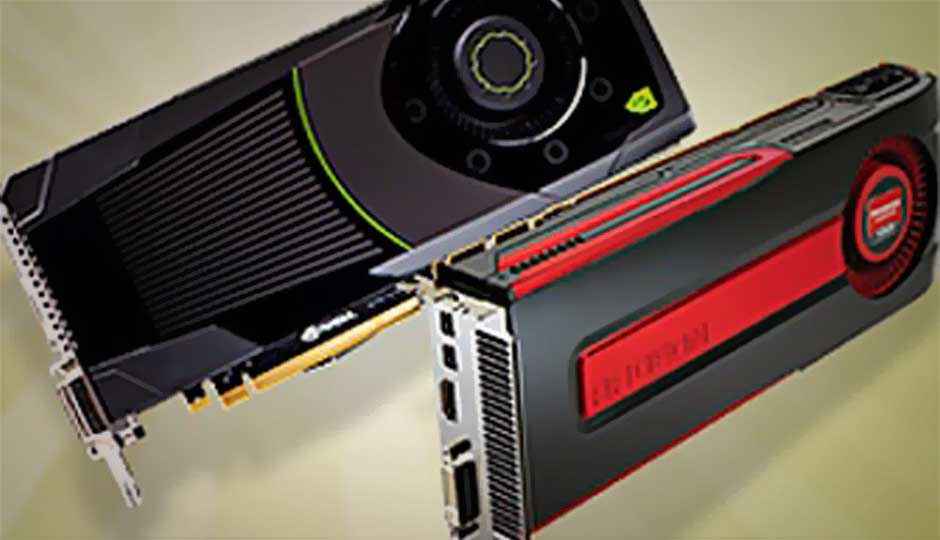Nvidia GeForce GTX 680 vs. AMD Radeon HD 7970

Of the major rivalries in the technology industry, few get as heated as often as that of Nvidia and AMD. When it comes to releasing new graphics hardware, the two companies take no mercy: Every year (or thereabouts, if they don’t bother to follow the calendar) they trade off the title of “the most powerful video card in the world” for this price range or that price range, and frequently leave consumers confused by the options available to them.
This is certainly true with regards to the companies’ two recent flagship video cards: the AMD Radeon HD 7970, which came out toward the end of last year, and Nvidia’s just-released GeForce GTX 680. Both are single-GPU models at the top of their respective lines, utilizing all the latest video display technologies; both promise outstanding frame rates in the hottest 3D games; and both cost around $500. So if you’re upgrading your computer, or building one from scratch, how can you choose between them?
To give you a better idea of whether you should buy the 7970 or the GTX 680, we’ve compiled this comparison of the cards’ salient features. Along with each is our verdict about which card succeeds in that category. If you’re looking for powerful single-card graphics for your PC games, either is a fine way to go. But one of these cards excels in more areas, and is thus the ultimate choice for today—and we’ll tell you what it is at the end.
Gaming Performance
Let’s face it: Pretty much the only reason people ever drop $500 or more on a video card is because they want to play the latest games. And in that department, the two cards run pretty much neck and neck most of the time. In our real-world game benchmarks, the 7970 only came out definitively ahead in Aliens vs. Predator, at both 1,920 by 1,200 (59.2 frames per second, or fps, versus 52fps) and 2,560 by 1,600 (37.4fps versus 31.7fps); and the GTX 680 proved superior at everything else (including two AMD-branded titles at the same resolutions, DiRT 3 and Total War: Shogun 2). On our synthetic benchmarks, which measure a broader scope of performance features that don’t necessarily show up in games, the GTX 680 also came out ahead: In Futuremark’s 3DMark 11 it scored 3,151 to the 7970’s 2,754, and beat the AMD card on the Heaven Benchmark 3.0 at 1,920 by 1,200 (43.6fps versus 40.5fps). The 7970 just barely edged out the GTX 680 when Heaven was upped to 2,560 by 1,600 (29.3fps versus 28.9), however. As with so many things, a lot depends on the games you play, but—even though its leads weren’t always decisive—the Nvidia card proved itself the champ more often.
Advantage: Nvidia
AMD Radeon HD 7970 vs. Nvidia GeForce GTX 680: Specs Compared
| AMD Radeon HD 7970 | Nvidia GeForce GTX 680 | |
| Stream Processors | 2,048 | 1,536 |
| Texture Units | 128 | 128 |
| ROP Units | 32 | 32 |
| Clock Speed | 925MHz | 1,006-1,058MHz (with GPU Boost) |
| Memory Clock | 5.5GHz | 6.008GHz |
| Memory Bus Width | 384 bit | 256 bit |
| Video Memory | 3GB GDDR5 | 2GB GDDR5 |
| TDP | 250 watts | 195 watts |
| Auxiliary Power Connectors | 1 6-pin, 1 8-pin | 2 6-pin |
| Recommended Power Supply | 500 watts | 550 watts |
| Display Outputs | 1 Dual-link DVI, 2 Mini DisplayPort, 1 HDMI | 2 Dual-link DVI, 1 DisplayPort, 1 HDMI |
| Price | $549 list | $499 list |
Price
If you can afford to buy either of these cards, clearly cash flow is not a problem for you at the moment. But that doesn’t mean price isn’t—or shouldn’t be—an issue: You undoubtedly want the best one you can get for the least amount of money. Right now, however, that’s not the 7970. It lists for $549, which is also the lowest price we found for one on Newegg. The GTX 680 lists for $499—and a number of those are available on Newegg for just that much.
Advantage: Nvidia
Technologies
Just looking at a spec sheet or a feature description doesn’t always tell you everything you need to know about a video card. The 7970 is based on an architecture named Graphics Core Next, which is heavily focused on parallel processing and scalability. For the GTX 680, Nvidia utilizes the Kepler architecture, a variation on the Fermi architecture it released in 2010. (Check out our basic rundown of Kepler for more details.) Both have their pluses and minuses in certain ways, and both represent major steps forward from their predecessors. There are some differences between the cards in terms of some features—for stereoscopic 3D AMD uses the open HD3D platform, Nvidia the proprietary 3D Vision; AMD cards are big on Eyefinity for easily setting up multiple displays (see the “Multimonitor Support” section below), whereas all of Nvidia’s cards have built-in physics processing with PhysX. But both cards support must-have technologies like DirectX 11 and PCI Express version 3.0, and for most people those are what will matter most. If you have a particular goal in mind, you might want to pay attention to these fine-print details, but those who just want a good card will find that both are sufficiently feature rich in most general ways.
Advantage: Tie
Compute Performance
Compute, or using the GPU to perform calculations that would traditionally be done by CPUs, isn’t something a lot of people think about, but it’s been a serious part of the reality of the video card market for a few years now. And given the overall power that video cards wield these days, we can see why. In our tests, the 7970, well, trounced its competitor in this department: On the 64-bit LuxMark 2.0 benchmark, the 7970 scored 1,591 on the Medium test and 987 on the Complex test—compared with the GTX 680’s 622 and 281 respectively. In the SiSoftware Sandra GP Processor test using OpenCL, the 7970 managed a rate of 2.2 gigapixels per second to Nvidia’s 756.4 megapixels per second; in Sandra’s GP Cryptography test, the 7970 managed a rate of 26.6GBps compared with the GTX 680’s 7GBps. Nvidia’s stumbling in this area is partially understandable, as it removed some of the GPU’s compute capabilities to make the cards using it more efficient. And chances are that compute won’t be at the top of your list of reasons to buy most any card. But if general-purpose computing matters to you, the choice is clear this time around.
Advantage: AMD
Multimonitor Support
How many monitors is enough these days? AMD began offering support for up to six simultaneous displays in 2009, and the 7970 proudly continues that tradition. Nvidia has been lagging behind in this way—with its 400 and 500 series the last couple of years, you’ve needed two cards to drive three monitors—but the GTX 680 takes a significant step forward: You can now connect up to four monitors at once to a single card. Most people will find that more than enough, but for the die-hards who really want to create a full wall of displays, AMD is still the better way to go.
Advantage: AMD
Power Usage
For years AMD has made energy efficiency a priority, and the company’s 7000-series cards have come armed with innovations that let them use a lot less power than cards from previous generations. The 7970 alone managed to draw slightly less power than Nvidia’s previous-generation GTX 580 (258.4 watts versus 262.5 watts) while surpassing it in most gaming tests. But Nvidia made a major turnaround this time, instituting a number of changes that sent the GTX 680’s power usage plummeting—well below even the impressive levels we witnessed with the 7970. Tested in exactly the same system, the GTX 680 used 298.2 watts of power, while producing better frame rates almost across the board. If you’re looking for the most power bill–friendly card you can find, right now there’s only one choice.
Advantage: Nvidia
And the Winner Is…
As we said at the outset, you can rest easy knowing that either the AMD Radeon HD 7970 or the Nvidia GeForce GTX 680 will give you a good single-card experience with recent hot PC games like Mass Effect 3, Batman: Arkham City, and The Elder Scrolls V: Skyrim. But the Nvidia card delivers more satisfying performance in most games, costs $50 less up front, and because it uses significantly less power than the AMD card it will also save you money in the long run. We admit that Nvidia’s supremacy may be short lived—the next generation of cards could hit at or around the time of the presidential election—but if you’re looking for the best single-GPU card you can get right now, the Nvidia GeForce GTX 680 is it.

